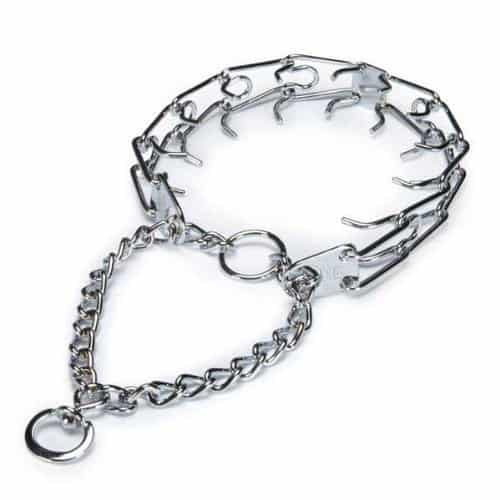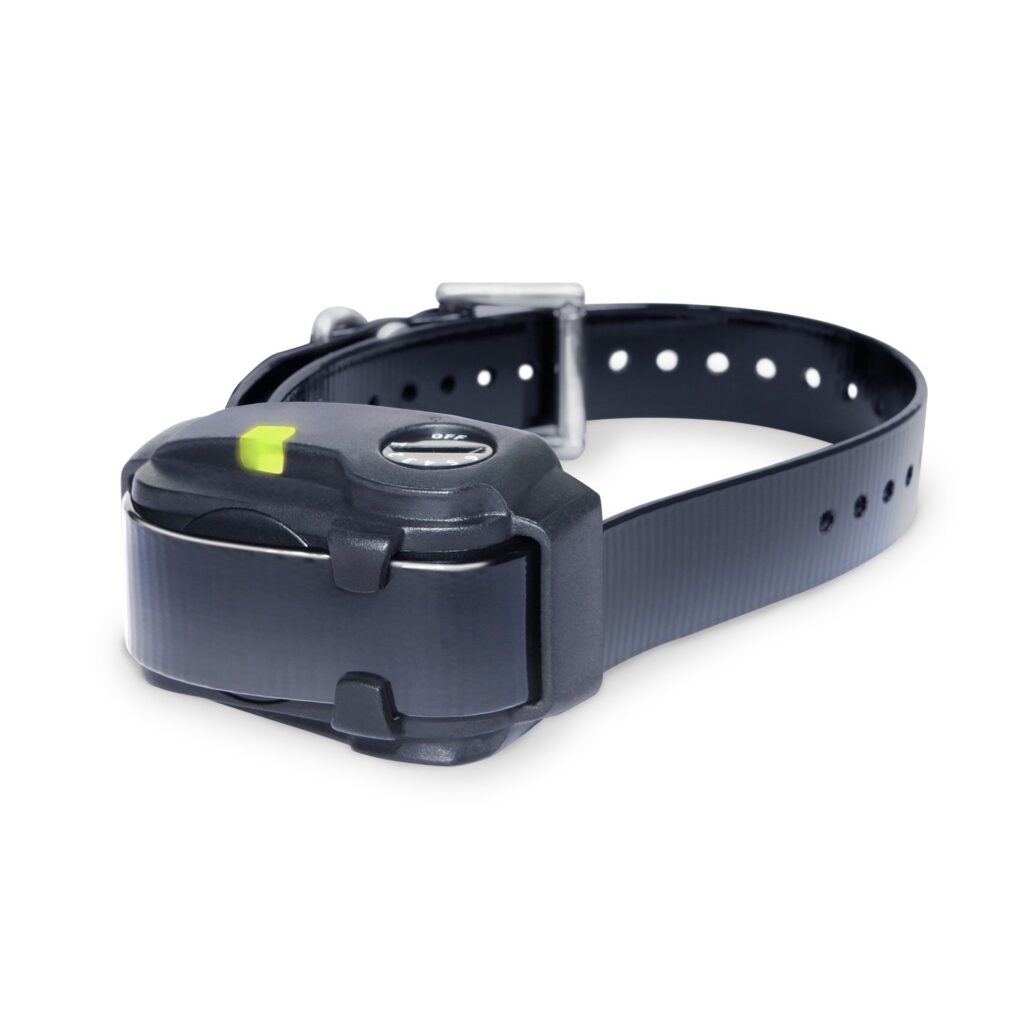At Highland Canine Training, our trainers often receive questions from clients about dog training equipment – in particular, dog training collars. Dog owners want to know more about the range of collars available, and which type of collar is most likely to be most suitable for their dog.
Different types of dog training require different collars. There is a wide variety of different dog collars available, and the choice is likely to depend on the overall goal for your training. The collar you choose to use with your dog for everyday walks will differ from, for example, a prong collar, which should only be used during specific training sessions.
Fitting a dog with the proper collar for the purpose you have in mind achieves optimal training results, contributes to the dog’s quality of life, and makes life easier for you as an owner.
In this article, we’ll cover different types of dog training collars, how they work, their features, and explain in which scenarios you will want to utilize them.
Flat collar

Flat collars are the most basic and popular type of dog collar. Virtually every dog owner has a flat collar that they put on their furry friends for walks.
Flat collars are simple and affordable for everyday use. They can be used effectively during your typical dog walks and training. The straightforward mechanism attaches and clips around your dog’s neck, usually with D-rings for attaching identification tags.
One note of caution is that dogs who pull on the leash can unintentionally hurt themselves with a flat collar. It must be fitted appropriately for the dog’s neck, and the owner shouldn’t pull the leash to get their dog’s attention unless absolutely necessary. This is why flat collars are usually made from soft materials.
In an ideal world, your dog should be able to walk without pulling on the leash – even when they are excited. A dog being walked on a flat collar who pulls or lunges risks neck strain or other injuries.
Flat collars can also be easy for your dog to squirm out of and make an escape.
However, fitted properly on a well-behaved pup, the convenience of the flat collar makes them one of the most popular choices with dog owners. The typical price for a flat collar is around $10-$25.
Pros of the flat collar
- Affordable, easy-to-use and convenient
- Usually adjustable
- Works well in everyday situations if your dog doesn’t lunge or pull on walks.
Cons of the flat collar
- Pulling on the leash when wearing a flat collar can cause neck or eye injuries to your dog
- Dogs can find ways to wriggle out of them and escape.
Martingale collar

Martingale collars are essentially a mix between flat collars and slip collars. They are made from soft materials, designed to allow you to control your dog without choking them.
The Martingale collar has two loops. When a dog is calm and relaxed, the collar simply sits easily on their neck. However, if they pull forward or lunge, the tension causes the smaller loop to tighten. As the dog relaxes, the collar loosens once again.
A properly fitted Martingale does not choke a dog, as the collar has a limit on how much it can tighten (unlike a choke collar, which has no limit). Nonetheless, repeated use or overuse of the Martingale can create neck problems.
These collars are an excellent choice for dogs with narrow heads proportional to their necks, such as Greyhounds, Afghan Hounds, and Doberman Pinschers. You can expect to pay in the region of $10-$25 for a Martingale collar.
Pros of the Martingale collar
- Affordable and simple to use
- Adjustable
- Offers comfortable security if fitted properly.
Cons of the Martingale collar
- Overuse or poor fitting can hurt your dog.
Prong collar

Prong collars (also known as pinch collars) should only be used for training in specific situations. A prong collar should never be left on a dog after a training session is complete.
These collars have stainless steel prongs attached to the chain links facing the dog’s neck. When tension is applied (either via a ‘pop and release’ from the person holding the leash, or from self-correction due to the tension generated by the dog themselves), the prongs apply pressure all the way around the dog’s neck.
Prong collars can be used to correct problematic behaviors such as jumping, lunging or pulling.
Correctly fitting the prong collar to your dog’s neck is essential. The prong collar must be fitted high on your dog’s neck, and tight enough to ensure that the pressure will be effective. If you are in doubt about how to use a prong collar, you should consult with a reputable, balanced dog trainer who will be able to demonstrate proper positioning and use of the collar.
Prong collars typically retail at around $20 to $30, depending on the size.
Pros of the prong collar
- Effective correction tool which can make situations safer for dogs and owners alike
- For issues like jumping or lunging, the prong collar will act as a self-correcting tool.
Cons of the prong collar
- For inexperienced users, they can be difficult to put on/remove from your dog
- Cannot, under any circumstances, be left on your dog for prolonged periods of time.
E-Collar

E-collars (also known as remote collars) are a versatile tool which can be used in several different facets of dog training, either to communicate with dogs off-leash, or for advanced obedience work.
Usually comprising a sturdy collar which sits on the dog’s neck, and a handheld remote operated by the handler, E-collars send adjustable wireless electric stimulation to provide feedback on the dog’s behavior. The receiver typically has adjustable levels which alters the level of stimulation.
E-collars can be used as a corrective tool or a communication tool. They are useful in any scenario where a dog is working away from their owner or handler. For example, they can be used to teach advanced obedience commands, or to increase your dog’s independence and safety on off-leash walks. They can also be used in specialized training disciplines such as Search and Rescue, with some E-collars even including a GPS tracker to help locate the dog.
As with any training tool, you should seek advice from a professional, certified dog trainer if you are unsure how to operate the E-collar correctly.
E-collars often vary in price. It is essential to find a model which has a wide selection of stimulation levels as this will ensure that you can find a level that is attuned to your dog’s behavior. A wide selection of levels does not mean that the E-collar is more ‘powerful’ – it simply means that you have more control over incremental increases in stimulation.
Pros of the E-collar
- Versatile – can be used for a range of activities
- Offers unparalleled control for off-leash walks, advanced obedience, etc.
Cons of the E-collar
- A good-quality, reputable brand can be expensive
- Requires knowledge of how to use them effectively and safely.
No bark collar

As the name indicates, no bark collars are self-correcting collars which automatically correct a dog when they bark.
Requiring little in the way of initial setup, they are a convenient choice for dog owners. With different stimulation ranges, there is an efficient level for dogs of every size. The major benefit of no bark collars is that the correction is instantaneous. Additionally, it requires little work from the owner, and the correction is consistent every single time. No bark collars typically run on rechargeable batteries and last for a long time between charges.
No bark collars can be an effective way to stop excessive barking, but be aware that it may not address the root cause of your dog’s barking. For example, your dog may be barking due to anxiety and/or illness. Additionally, leaving your no-bark collar on your dog for extended periods whilst they are in their crate can create negative associations.
No bark collars are priced between $50 and $100, with more expensive models offering a wider range of stimulation levels.
Pros of the no bark collar
- Convenient and easy-to-use
- Provides instant corrections at the moment your dog barks
Cons of the no bark collar
- May not resolve the root cause of the barking
- Can be more expensive
In conclusion
With so many different types of dog training collars available, it is no surprise that inexperienced dog owners may be confused about the best choice for their dog.
Whilst the information in this article is designed to help you, if you are unsure about which collar is most suitable, you should consult a professional dog trainer for advice. They will be able to guide you on the best collar choice for your individual circumstances and dog training goals.


You must be logged in to post a comment.